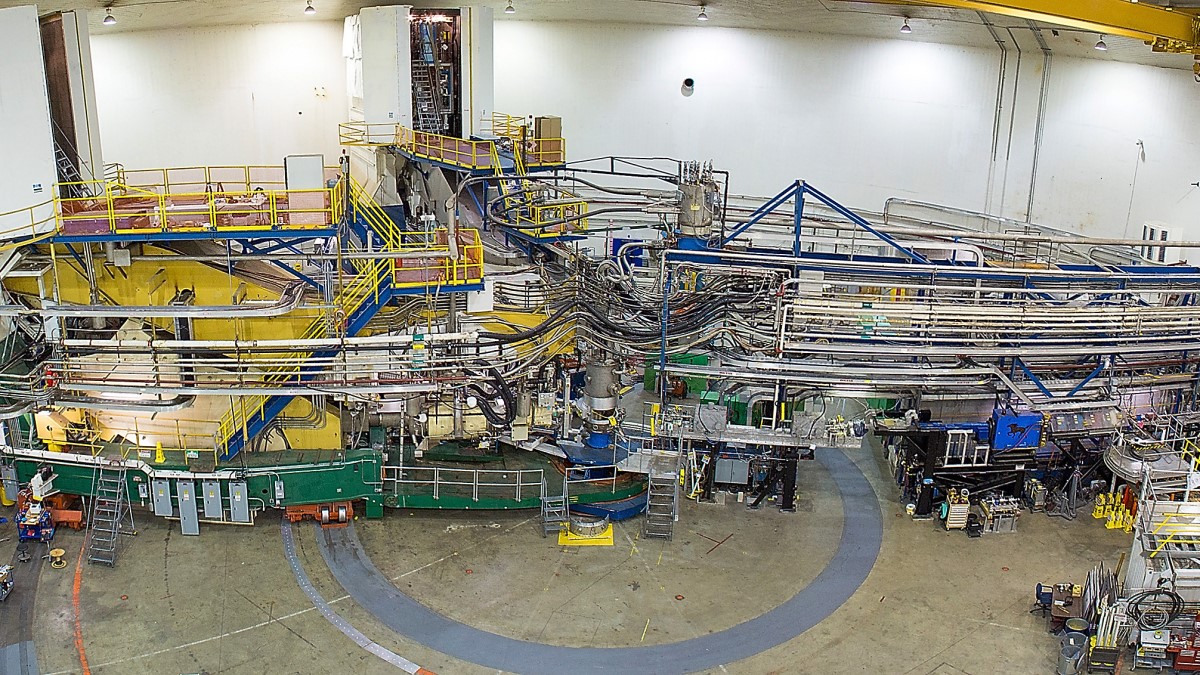Science
Groundbreaking Electron Scattering Reveals Three-Nucleon Interactions

An experiment at Jefferson Lab in the United States has uncovered the first evidence of short-range correlations among three nucleons, challenging existing models of nuclear interactions. Conducted in 2018, the research involved scattering high-energy electrons off helium-3 and tritium nuclei, revealing insights that may enhance our understanding of atomic nuclei and the enigmatic properties of neutron stars.
Atomic nuclei are composed of nucleons — protons and neutrons — bound together by the strong force. These nucleons exhibit dynamic behavior, moving independently or in correlated groups. Understanding these correlations is crucial for deciphering the interactions that define both small atomic structures and massive celestial bodies like neutron stars. By measuring the momenta of nucleons through electron scattering, scientists can gain valuable insights into their correlated motion.
Insights from Electron Scattering
High-energy electron beams allow researchers to isolate individual nucleons, as the de Broglie wavelength of the electrons is smaller than the nucleons themselves. During the scattering process, momentum is exchanged between the nucleons and electrons, offering a window into the correlations that exist among them. Previous studies indicated that most momentum in nuclei is linked to single nucleons, with some attributed to correlated pairs. This latest research suggests the presence of additional, unexplained momenta.
“We know that the three-nucleon interaction is important in the description of nuclear properties, even though it’s a very small contribution,” explained John Arrington from the Lawrence Berkeley National Laboratory. “Until now, there’s never really been any indication that we’d observed them at all. This work provides a first glimpse at them.”
Arrington, along with an international team of physicists, analyzed data from the electron scattering experiments at Jefferson Lab, specifically targeting helium-3 and tritium for their unique properties. These isotopes are termed “mirror nuclei,” with tritium containing one proton and two neutrons, while helium-3 has two protons and one neutron. This relationship allows for a clearer examination of nucleon interactions.
Challenges and Future Directions
Investigating three-nucleon correlations is advantageous, as the absence of interactions involving four or more nucleons simplifies the analysis. Principal investigator Shujie Li noted, “We’re trying to show that it’s possible to study three-nucleon correlations at Jefferson Lab even though we can’t get the energies necessary to do these studies in heavy nuclei.” The research team utilized the light nuclei of tritium and helium-3 to create a clearer picture of these interactions, despite the challenges associated with these radioactive materials.
Both helium-3 and tritium are rare isotopes. Tritium, which has a half-life of approximately 12 years and is toxic if ingested or inhaled, is produced in nuclear reactors and through the radioactive decay of helium-3. To facilitate their experiments, the research team designed a specialized cryogenic chamber to contain tritium gas, allowing for controlled measurements.
The analysis of the scattering experiments has provided intriguing evidence of three-nucleon short-range correlations, although further investigation is required to understand the mechanics behind these interactions. It remains to be determined if three nucleons can correlate simultaneously or if a correlated pair can link with a third nucleon.
These three-nucleon interactions are thought to play a significant role in the properties of neutron stars, suggesting that further study of these small nuclei could yield insights into the complexities of much larger astronomical bodies. Arrington added, “It’s much easier to study a three-nucleon correlation in the lab than in a neutron star.”
The findings of this research have been published in Physics Letters B. As scientists continue to unravel the mysteries of nuclear interactions, this pioneering work at Jefferson Lab represents a significant step toward deeper understanding of the fundamental forces that govern both the smallest particles and the largest cosmic entities.
-

 Entertainment3 weeks ago
Entertainment3 weeks agoLove Island Star Toni Laite’s Mother Expresses Disappointment Over Coupling Decision
-

 Entertainment3 weeks ago
Entertainment3 weeks agoWoman Transforms Life with Boot Camp, Losing Nearly 9 Pounds in a Week
-

 Science3 weeks ago
Science3 weeks agoAstronomers Discover Giant Exoplanet in Star’s Dusty Surroundings
-

 Lifestyle3 weeks ago
Lifestyle3 weeks agoBring Birds to Events and Dine with Style: Trends This Week
-

 World3 weeks ago
World3 weeks agoCoronation Street Recasts Lily Platt Amid Dramatic Storyline
-

 Entertainment2 weeks ago
Entertainment2 weeks agoMary Goskirk’s Injury Raises Questions in Emmerdale Episode
-

 Sports3 weeks ago
Sports3 weeks agoGAA Faces Controversial Decision on DJ Carey Before Final
-

 Entertainment3 weeks ago
Entertainment3 weeks agoBob Vylan Drops Out of European Tour with Gogol Bordello After Controversy
-

 Lifestyle3 weeks ago
Lifestyle3 weeks agoAylesbury Committee Approves Controversial 24-Hour McDonald’s
-

 Entertainment3 weeks ago
Entertainment3 weeks agoJessica Alba’s New Relationship Unveiled with Younger Actor
-

 Entertainment3 weeks ago
Entertainment3 weeks agoKeeley Hawes Takes Risks in High-Octane New Series The Assassin
-

 Top Stories3 weeks ago
Top Stories3 weeks agoNicki Minaj and SZA Engage in Heated Social Media Feud









